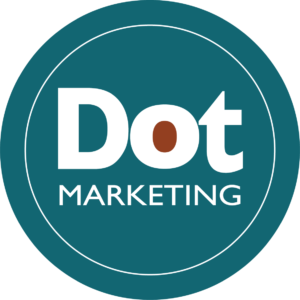Creating a successful marketing strategy is essential for business growth. It’s a roadmap that guides your actionable items and helps you achieve your marketing goals. Dot Marketing has helped hundreds of businesses with implementation and the optimization of their marketing tactics. To be successful with that, some key things need to be identified in the foundation of this marketing adventure. Our Marketing Strategy Builder worksheet provides a structured approach to building this marketing foundation.
Download our Marketing Strategy Worksheet so you can be building your marketing strategy while reading our article.

Here are the steps!
1. Analyze the Market
Understanding your customer is fundamental to a successful marketing strategy.
This involves:
- Identifying Your Target Audience: Who are you trying to reach? What are their needs, wants, and pain points?
- Analyzing Competitors: What are your competitors doing well? How can you differentiate your business?
- Market Trends: What are the current trends in your industry? How can you capitalize on them?
2. Define Your Goals
Clear and measurable goals are crucial for effective marketing and should align with your overall business goals.
Your goals should be:
- Specific: Clearly defined and focused.
- Measurable: Quantifiable with specific metrics.
- Achievable: Realistic and attainable.
- Relevant: Aligned with your overall business objectives.
- Time-bound: With a clear deadline.
Examples of SMART Marketing Goals:
- Increase website traffic by 20% next quarter.
- Generate one qualified business lead per week.
- Improve email engagement by 15% within 3 months.
3. Develop a Brand Message
Your brand message is the heart and soul of your marketing efforts. It’s the unique story you tell about your business, connecting with your audience on an emotional level. A strong brand message guides your marketing efforts, creating a consistent customer experience.
Core Components of a Brand Message
- Mission and Vision: Your mission outlines your business’s purpose, while your vision defines your long-term goals. These statements provide a clear direction for your brand. For example, a fitness company’s mission might be to inspire healthy lifestyles, and its vision could be to become the leading wellness platform in the region.
- Compelling Offers: What unique value do you provide to your customers? Clearly articulate the benefits of your products or services. Rather than simply stating “We sell shoes,” highlight the comfort, style, and performance your shoes offer.
- Call to Action: Tell your audience what you want them to do next. Whether it’s making a purchase, signing up for a newsletter, or requesting a quote, a clear call to action drives engagement. For instance, “Shop Now” or “Book a Consultation.”
- Brand Personality: Define your brand’s character. Is it friendly, professional, innovative, or something else? Your personality should align with your target audience. A tech startup might adopt a playful and energetic personality, while a law firm would opt for a more professional and trustworthy image.
- Brand Voice: This is the language and tone you use to communicate your brand message. It should be consistent across all marketing materials. For example, a casual, conversational tone for a social media platform versus a formal, authoritative tone for a legal document.
- Brand Story: Every brand has a story. Share your journey, values, and how you help customers. A handcrafted jewelry brand might share the story of its artisans and the inspiration behind their designs.
4. Choose Your Marketing Channels
Selecting the right marketing channels is essential for reaching your target audience.
Consider factors such as:
- Target Audience Preferences: Where do they spend their time online?
- Budget: How much can you allocate to each channel?
- Goals: Which channels best align with your marketing objectives?
Some examples of marketing channels include:
- Social Media
- Email Marketing
- Content Marketing
- Paid Digital Advertising
- Billboard Advertising
5. Implement Marketing Tactics and Action Items
Once you’ve defined your goals and chosen your channels, it’s time to create specific marketing tactics and action items.
These should be:
- Aligned With Your Goals: Ensure each tactic contributes to your overall objectives.
- Specific and Measurable: Clearly defined with key performance indicators (KPIs).
- Time-Bound: With deadlines for completion.
Examples of marketing tactics that would need to be completed in a specific order are:
- Developing Content
- Making a Blog Post on Your Website
- Promoting the Blog Post on Social Media
6. Track, Analyze, and Optimize
Continuous monitoring and analysis are essential for improving your marketing performance. Track your KPIs, analyze the data, and make adjustments as needed.
This involves:
- Setting Up Tracking Systems: Use analytics tools to measure website traffic, social media engagement, and other relevant metrics. The best tool to start with is Google Analytics. You can track website traffic and sources that traffic came from. Other tracking systems may include social media software or search engine tracking software.
- Analyzing Performance: Regularly review your data to identify trends and patterns. Most businesses need to analyze the data at least monthly, but it depends on the type of business and what is set for KPIs.
- Making Data-Driven Decisions: Use insights to optimize your marketing campaigns. If it’s not working, then change it. Sometimes marketing tactics need time to tell if they will work, so you may need to be patient for instance on a creative advertising campaign.
By following these steps and using the Marketing Strategy Builder worksheet below, you can create a comprehensive and effective marketing strategy for your business.
Remember, marketing is an ongoing process, so be prepared to adapt and adjust your strategy as needed. If you need help selecting marketing channels or completing actionable items with analyzation and optimizing, that’s where Dot Marketing shines!
Contact us today to discuss how we can help you be successful with your marketing efforts.
